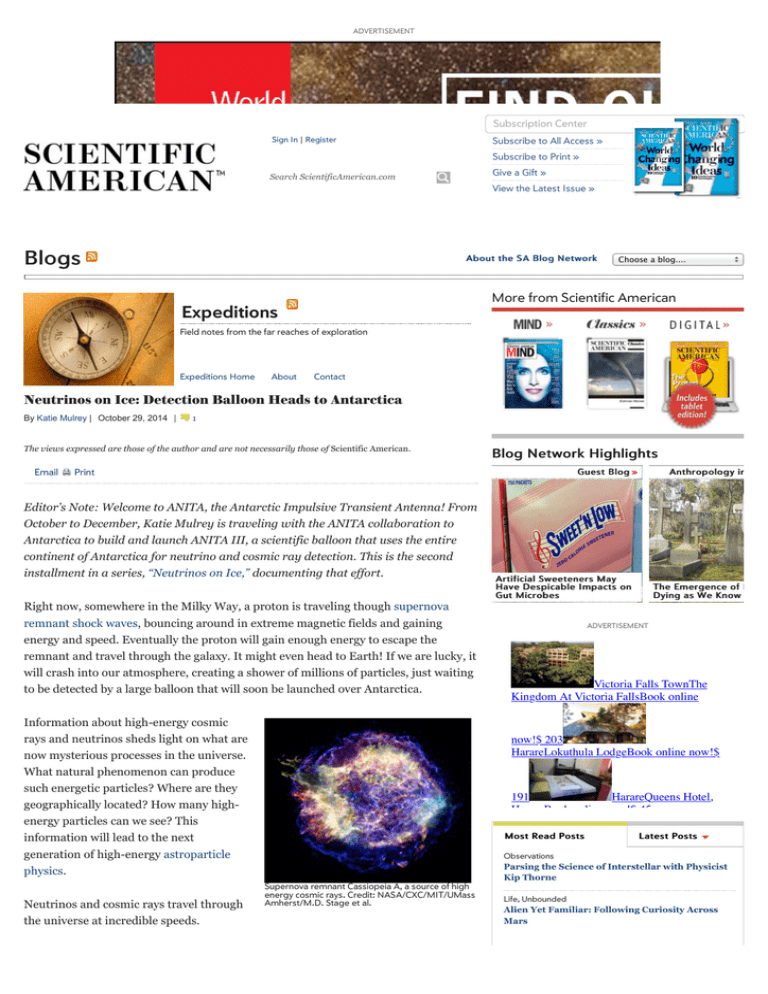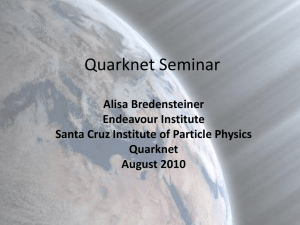
ADVERTISEMENT
Subscription Center
Sign In | Register
Subscribe to All Access »
Subscribe to Print »
Give a Gift »
Search ScientificAmerican.com
View the Latest Issue »
Blogs
About the S A Blog Network
Choose a blog....
More from Scientific American
Expeditions
Field notes from the far reaches of exploration
Expeditions Home
About
Contact
Neutrinos on Ice: Detection Balloon Heads to Antarctica
By Katie Mulrey | October 29, 2014 |
1
The views expressed are those of the author and are not necessarily those of Scientific American.
Email
Blog Network Highlights
Print
Guest Blog »
Editor’s Note: Welcome to ANITA, the Antarctic Impulsive Transient Antenna! From
October to December, Katie Mulrey is traveling with the ANITA collaboration to
Antarctica to build and launch ANITA III, a scientific balloon that uses the entire
continent of Antarctica for neutrino and cosmic ray detection. This is the second
installment in a series, “Neutrinos on Ice,” documenting that effort.
Right now, somewhere in the Milky Way, a proton is traveling though supernova
remnant shock waves, bouncing around in extreme magnetic fields and gaining
energy and speed. Eventually the proton will gain enough energy to escape the
remnant and travel through the galaxy. It might even head to Earth! If we are lucky, it
will crash into our atmosphere, creating a shower of millions of particles, just waiting
to be detected by a large balloon that will soon be launched over Antarctica.
Information about high-energy cosmic
rays and neutrinos sheds light on what are
now mysterious processes in the universe.
What natural phenomenon can produce
such energetic particles? Where are they
geographically located? How many highenergy particles can we see? This
information will lead to the next
generation of high-energy astroparticle
physics.
Neutrinos and cosmic rays travel through
the universe at incredible speeds.
Anthropology in Prac
Artificial Sweeteners May
Have Despicable Impacts on
Gut Microbes
The Emergence of Death
Dying as We Know It
ADVERTISEMENT
Victoria Falls TownThe
Kingdom At Victoria FallsBook online
now!$ 203
HarareLokuthula LodgeBook online now!$
191
HarareQueens Hotel,
HarareBook online now!$ 45
Most Read Posts
Latest Posts
Observations
Supernova remnant Cassiopeia A, a source of high
energy cosmic rays. Credit: NASA/CXC/MIT/UMass
Amherst/M.D. Stage et al.
Parsing the Science of Interstellar with Physicist
Kip Thorne
Life, Unbounded
Alien Yet Familiar: Following Curiosity Across
Mars
Neutrinos are fundamental particles in nature, and part of the Standard Model of
Observations
particle physics. The name neutrino means “neutral little one.” As the name suggests,
neutrinos have no charge, and so they are hard to detect. Cosmic rays are charged
The Fossil That Revolutionized the Search for
Human Origins: A Q&A with Lucy Discoverer
Donald Johanson
particles, commonly protons or other atomic nuclei, that are very energetic and travel
at speeds close to the speed of light. Cosmic rays are the most energetic particles ever
observed (far greater in energy than anything that can be produced in particle
accelerators) and they should produce nearly as energetic neutrinos by interacting
with the light left over from the Big Bang—the cosmic microwave background (CMB).
Observations
Dog Physics: How Your Pet Solves Its Drinking
Problem [VIDEO]
Observations
Can China Cut Coal?
We are talking about energies in the 1019 electron-volt range and higher! It is almost
impossible to grasp what energies this high really mean. The visible light we see tends
Follow Us:
to be on the order of 1 electron volt. A 1019 electron-volt proton has the same energy
as a baseball thrown at 60 miles per hour!
See what we're tweeting about
Scientific American Contributors
These particles have to undergo
extreme acceleration to achieve these
energies. Sources of lower energy
neutrinos and cosmic rays are fairly
well known. Our sun, for example,
produces many lower energy neutrinos
via nuclear fusion. We don’t think too
much about neutrinos on a daily basis,
but in fact, 65 billion neutrinos pass
through your fingernail every second!
Neutrino image of the sun from the Super Kamiokande
neutrino detector. Credit: L R. Svoboda and K. Gordan
(LSU)
sciammind Cyber Monday Blowout Sale!
20% off sitewide http://t.co/vCSqkvliMv
http://t.co/hQ4DBowdlz
1 hour ago · reply · retweet · favorite
sciam Fat to blame for half a million cancers
per year. http://t.co/oocmBpDVpm #Cancer
#science
2 hours ago · reply · retweet · favorite
LeeBillings RT @albertoconti: ESPRESSO: A
scientific Pandora's box
http://t.co/9tFFCkV2Y6
4 hours ago · reply · retweet · favorite
Since low energy cosmic rays and
neutrinos are more abundant,
scientists have a better grasp of their
More »
sources and composition.
High-energy neutrinos and cosmic rays pose a larger problem. The origin of highenergy neutrinos and cosmic rays is unknown, and more information about these
particles will shed light on the most energetic processes in the universe: supernovae,
active galactic nuclei, gamma ray bursts, etc. The problem is that they are much rarer
than their lower energy counterparts, and so very difficult to detect. In order to
detect these particles you either need a telescope with a huge detection area or a huge
amount of detection time, or both.
Latest Headlines on Scientific American.com
New Class of Polymers Discovered By Accident
Head Games - November/December 2014
Texas Releases More than 50 Sea Turtles
Treated for Cold-Stunning
Crying Baby Mammals All Sound the Same to
Mama
France to Rank Cars for Pollution
Latest from
Morsels For The Mind – 28/11/2014
In Praise of the Turkey (and its genome)
Eastern European countries snub neighbours’
science policy
Skin Cancers — Causes and Treatment
Study sheds light on Serbia’s research
productivity: good output, poor quality
More »
ADVERTISEMENT
An artist's depiction of a cosmic ray air shower. Credit: Simon Swordy (U. Chicago), NASA.
When cosmic rays enter the atmosphere they interact with particles in the
atmosphere, creating particle cascades, aka “air showers” (see above figure). A similar
phenomenon happens when high-energy neutrinos pass through a dense material
such as ice. The cascade development generates electromagnetic radiation that can be
seen in many wavelengths, including the optical and radio spectrums.
Detectors tuned for specific wavelengths can be used to detect cosmic ray air showers
with radiation from different parts of the electromagnetic spectrum. Enter ANITA, an
instrument consisting of 48 antennas arranged on a balloon payload to scan the
entire continent of Antarctica for radio signals that come from neutrinos interacting
in the ice, as well as cosmic rays interacting in the atmosphere and reflecting off the
ice. Large detection areas are very hard to build, so we use what nature gave us – a
huge sheet of ice, perfect radio detection!
Subscribe
News & Features
Topics Blogs
Video of the Week
Videos & Podcasts Education Citizen Science
SA Magazine SA Mind
Books
SA en español
A Paper Puppet Homage to Microbes
Image of the Week
Schematic of radio emission from neutrinos. Credit: S. Hoover.
There have been two ANITA flights so far. Both have detected cosmic rays and have
been important for neutrino research. This all leads to ANITA III, which was
assembled for the first time last summer at a NASA balloon facility in Palestine, Texas
(where the climate was very different from ANITA’s final destination). Scientists
worked for two months to build and test this experiment, which has been years in the
making. In order to proceed, the instrument had to pass two tests. The first test was
to make sure the payload wouldn’t fall apart under its own weight, nearly 2.5 tons!
The second was to ensure that scientists on the ground could communicate with the
instrument while it is flying around Antarctica. The instrument passed both crucial
tests in late August.
So what happens next? We take it all apart: the 30-foot-high gondola structure that
houses 48 antennas, the communication equipment, loads of cabling and the
“instrument box” (the heart of ANITA that processes and records the data).
Everything is put in huge shipping containers and sent south to Antarctica, where we
will meet it in late October when the austral summer begins.
What do we expect to see? Seeing any neutrinos would definitely be awesome. Two
things are happening in the high-energy neutrino world: experiments are becoming
more sensitive and models are getting better. ANITA’s goal is to bridge the gap
between experiment and theory. Models put a limit on the number of neutrinos we
can expect to see. If we don’t see any within that limit it means the models may need
to be changed. In that sense, any news will be good news. If we see neutrinos, we can
confirm and tweak the models. If we don’t, we can put constraints on model. Cosmic
rays, however, are expected to be bountiful.
Team SciTweeps in Lego-Form
The ANITA instrument. Those white things are the antennas.
Credit: K. Mulrey.
Part of the ANITA III collaboration, after passing NASA's balloon program “hang test” in Palestine, Texas last
summer. Photo Credit: Harm Schoorlemmer.
That’s ANITA in a nutshell. As we assemble the instrument we will dig into the nittygritty details. In the meantime, the first wave of collaborators are boarding planes for
the 20-plus hour flights to Christchurch, New Zealand. The city houses the Antarctic
Clothing Distribution Center where you pick up all your winter weather gear,
including huge boots, that notorious red jacket, wind pants, hats, gloves and more. It
is also the best place to fly to the side of the continent where McMurdo Station is
located.
See you in the south!
About the Author: Katie Mulrey received a B.S. in Physics and Mathematics at the University of Mary
Washington in 2008. She is now in the final phase of her Ph.D. work in High Energy Particle
Astrophysics at the University of Delaware. Katie is a part of the ANITA collaboration and is heading to
Antarctica to participate in the 2014 ANITA balloon campaign, which will probe the highest energy processes in
the universe.
More »
The views expressed are those of the author and are not necessarily those of Scientific American.
Tags: antarctica
antarctica,, cosmic rays
rays,, Neutrinos on Ice
Ice,, particle physics
physics,, Standard Model
Previous: MIT Neurotech:
Mapping the Brain with
Connectomics
More
Expeditions
Next: MIT Neurotech:
Tapping into Neurons
with Autopatching
Rights & Permissions
Like
188
Tweet
19
9
Share
StumbleUpon
1 Comment
1. MargaretLHanna
8:36 am 10/30/2014
Add Comment
Start working at home with Google! It’s by-far the best job I’ve
had. Last Wednesday I got a brand new BMW since getting a
check for $6474 this – 4 weeks past. I began this 8-months
ago and immediately was bringing home at least $77 per hour.
I work through this link, go to tech tab for work detail
———————-> http://www.jobs700.com
Link to this
Add a Comment
You must sign in or register as a ScientificAmerican.com member to submit a comment.
Scientific American is a trademark of Scientific American, Inc., used with permission
© 2014 Scientific American, a Division of Nature America, Inc.
YES! Send me a free issue of Scientific
All Rights Reserved.
American with no obligation to continue
the subscription. If I like it, I will be billed
for the one-year subscription.
Subscribe Now
Advertise
About Scientific American
Give a Gift
Special Ad Sections
Press Room
Renew Your Print Subscription
SA Custom Media and
Partnerships
Site Map
Print Subscriber Customer
Service
Science Jobs
Partner Network
International Editions
Travel
Terms of Use
Privacy Policy
Use of Cookies
Buy Back Issues
FAQs
Contact Us





